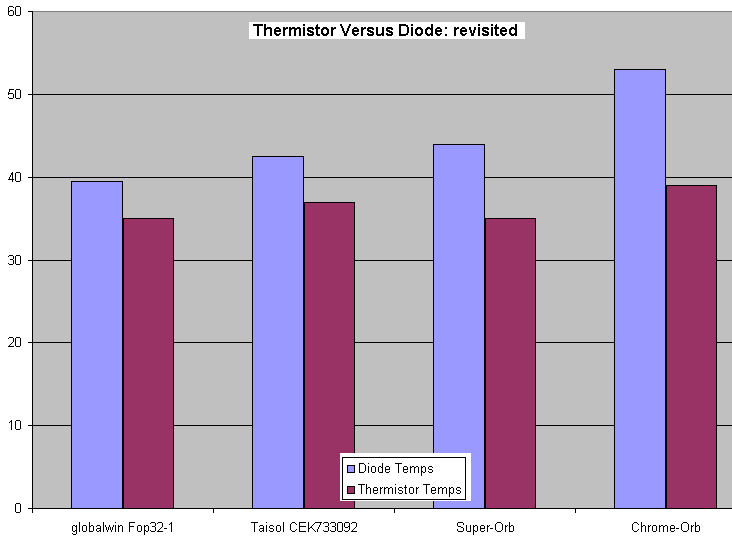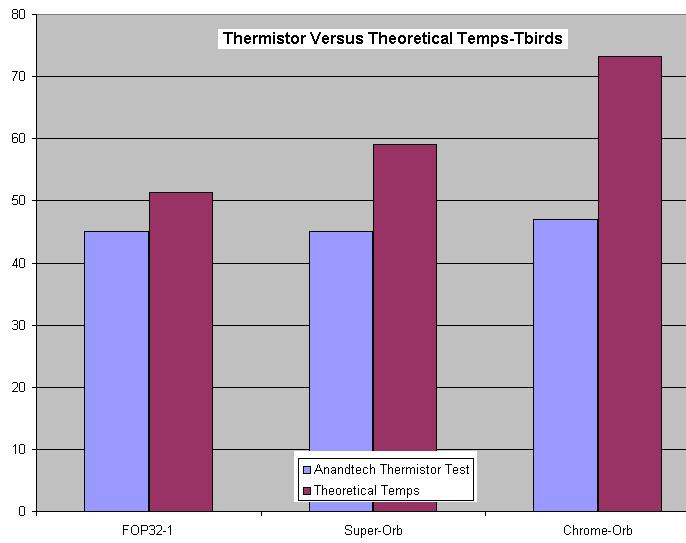|
|
|
IV. P3 Internal Diode Versus Socket-Thermistor Heatsink Tests(in progress)
To re-examine the diode versus thermistor tests, Nevin(of arctic silver fame) went out and purchased the following heatsinks at a computer show: Globalwin FOP32-1; Taisol CEK733092; Thermaltake Super-Orb and Chrome-Orb.
The PCTC-Pad on all the heatsinks was removed, and Arctic Silver was used instead. The clips were un-modified(clip pressure being higher than that required for intel CPUs).
CPU temps were measured via Internal Diode, and by a thermistor stuck directly behind the cpu core(to simulate socket-thermistor testing).
CPU: Celeron 2 @ 936, 1.9V(~34W)
Ambient case temperature(measured 1 inch from cpu fan intake): 25C.
Every test was repeated 3 times:

From looking at the graph, something very serious is going on with the Thermaltake sinks. I sincerely hope that Thermaltake is not relying on socket-thermistor tests to incorrectly reflect their heatsink/fan performance. For example, the Globalwin exhibits a 4.5C temperature difference from internal diode versus thermistor. The S-orb exhibits a 9C temperature drop, and the C-orb exhibits a whopping 14C temperature drop going from internal diode to thermistor. the taisol unit exhibits a 4C drop from diode to thermistor. Something seriously wrong is happening, and one theory is the way airflow goes 360 degrees around the heatsink, while other heatsinks(like the globalwin and taisol) only go around two sides. The other important factor is that the socket-thermistor only contacts the cpu backside at one point. The other 99% are contacting socket air, therefore any air interference will disrupt this reading.One thing I have completely forgotten about.
I personally think these problems are very serious, since reviews on the internet(tested with socket-thermistors) place the Chrome orb only a hair behind the FOP32-1, and the Super Orb tying the FOP32-1/Alpha's etc.
Now, doing a rough comparison and translating the results to a socket-A(t-bird 950 @ 1.8V, to simulate Anandtech Heatsink Comparison Results), we get the following:

Again, thermistor tests are shown to be inaccurate, unrelative results. They do not show full-relative changes, and the compression of results can be very misleading for an end-user, as this compression can be very misleading.
That being said, Chrome-orbs have uses, but for lower end overclocks. High-range overclocks are simply too much for the heatsink to handle, despite thermsitor "lies" saying otherwise.
The Most Important Issue: Socket-thermistor tests, yet again, have been shown to be compressed, unpredictable and inaccurate temps. They do not provide relative temperature differences for different heatsinks.
Conclusion (of a definite work in progress):
Websites have a responsibility to the reader to provide both accurate, and in the case of cooling, relative results in their reviews/comparisons. With AMD gaining steam very quickly in the Enthusiast computer user market, it is also exposing a lot of new users to overclocking. For these new users, reviews like those at HardOCP, Anandtech, and Toms Hardware serve as confusion. If socket A temp measurements were inaccurate, but accurately portrayed cpu core temperature differences, this webpage would not exist. The problem is the thermistor solution isn't relative: You can see a 10C Core Temp Difference Shown as a 1C difference in the Toms Hardware review, and a 10C difference shown as a 2C difference in the Anandtech Review.
It is not my place to force upon these websites to at least amend their reviews to simply state that the measurements are not really relative, nor accurate. But I do feel that a webmaster/owner has responsibility to spread correct knowledge, not to spread disinformation and sow confusion.
Solutions? And Calculating Your Own Theoretical Temps